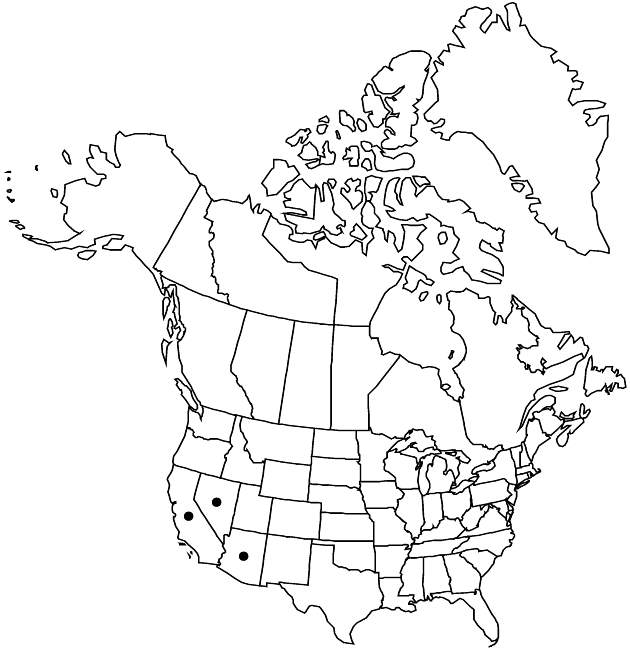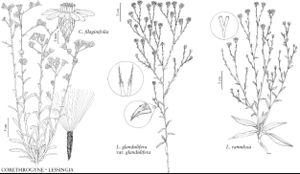Difference between revisions of "Lessingia glandulifera var. glandulifera"
FNA>Volume Importer |
FNA>Volume Importer |
||
| Line 31: | Line 31: | ||
|elevation=500–2400 m | |elevation=500–2400 m | ||
|distribution=Ariz.;Calif.;Nev.;Mexico (Baja California). | |distribution=Ariz.;Calif.;Nev.;Mexico (Baja California). | ||
| − | |discussion=<p>As here circumscribed, <i></i>var.<i> glandulifera</i> includes plants that lack a colored band in corolla tubes and have lanceolate style-branch appendages (others have treated those plants as <i>Lessingia</i> lemmonii <i></i>var.<i> lemmonii</i>). Also included are plants that sometimes form tumbleweeds and have puberulent phyllaries and overlapping cauline leaves that clasp the bases of involucres (others have treated those as L. lemmonii var. ramulosissima). In California, <i></i>var.<i> glandulifera</i> is known from the Transverse Range, the Peninsular Range, and the Mojave Desert (north to Mono County).</p> | + | |discussion=<p>As here circumscribed, <i></i></i>var.<i><i> glandulifera</i> includes plants that lack a colored band in corolla tubes and have lanceolate style-branch appendages (others have treated those plants as <i>Lessingia</i> lemmonii <i></i></i>var.<i><i> lemmonii</i>). Also included are plants that sometimes form tumbleweeds and have puberulent phyllaries and overlapping cauline leaves that clasp the bases of involucres (others have treated those as L. lemmonii var. ramulosissima). In California, <i></i></i>var.<i><i> glandulifera</i> is known from the Transverse Range, the Peninsular Range, and the Mojave Desert (north to Mono County).</p> |
|tables= | |tables= | ||
|references= | |references= | ||
| Line 55: | Line 55: | ||
|publication year= | |publication year= | ||
|special status= | |special status= | ||
| − | |source xml=https://jpend@bitbucket.org/aafc-mbb/fna-data-curation.git/src/ | + | |source xml=https://jpend@bitbucket.org/aafc-mbb/fna-data-curation.git/src/f6b125a955440c0872999024f038d74684f65921/coarse_grained_fna_xml/V19-20-21/V20_1045.xml |
|tribe=Asteraceae tribe Astereae | |tribe=Asteraceae tribe Astereae | ||
|genus=Lessingia | |genus=Lessingia | ||
Revision as of 18:39, 24 September 2019
Stems glabrous or villous. Abaxial leaf faces glabrous or villous. Involucres obconic to cylindric, 4–7 mm. Phyllaries glabrous or villous. Disc florets 17–30; style-branch appendages lanceolate, 0.3–1.3 mm. 2n = 10.
Phenology: Flowering May–Oct.
Habitat: Desert areas, chaparral, pine forests, usually sandy soils
Elevation: 500–2400 m
Distribution

Ariz., Calif., Nev., Mexico (Baja California).
Discussion
As here circumscribed, var. glandulifera includes plants that lack a colored band in corolla tubes and have lanceolate style-branch appendages (others have treated those plants as Lessingia lemmonii var. lemmonii). Also included are plants that sometimes form tumbleweeds and have puberulent phyllaries and overlapping cauline leaves that clasp the bases of involucres (others have treated those as L. lemmonii var. ramulosissima). In California, var. glandulifera is known from the Transverse Range, the Peninsular Range, and the Mojave Desert (north to Mono County).
Selected References
None.
